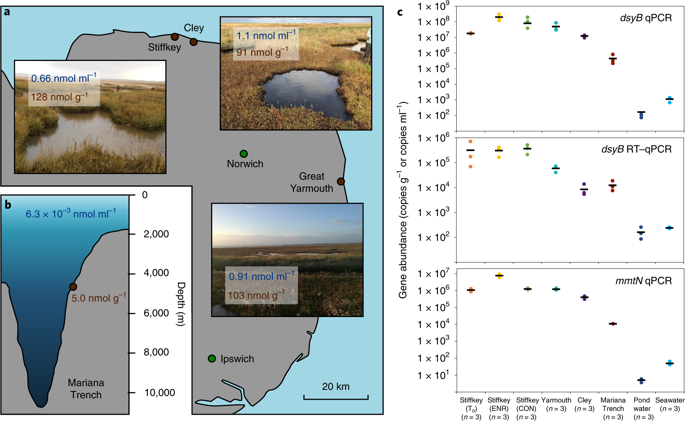当前位置:
X-MOL 学术
›
Nat. Microbiol.
›
论文详情
Our official English website, www.x-mol.net, welcomes your
feedback! (Note: you will need to create a separate account there.)
Bacteria are important dimethylsulfoniopropionate producers in coastal sediments.
Nature Microbiology ( IF 20.5 ) Pub Date : 2019-08-19 , DOI: 10.1038/s41564-019-0527-1 Beth T Williams 1 , Kasha Cowles 1 , Ana Bermejo Martínez 1 , Andrew R J Curson 1 , Yanfen Zheng 1, 2 , Jingli Liu 1, 2 , Simone Newton-Payne 1 , Andrew J Hind 3 , Chun-Yang Li 2 , Peter Paolo L Rivera 1 , Ornella Carrión 3 , Ji Liu 1, 2 , Lewis G Spurgin 1 , Charles A Brearley 1 , Brett Wagner Mackenzie 4 , Benjamin J Pinchbeck 1 , Ming Peng 5 , Jennifer Pratscher 6 , Xiao-Hua Zhang 2 , Yu-Zhong Zhang 5 , J Colin Murrell 3 , Jonathan D Todd 1
Nature Microbiology ( IF 20.5 ) Pub Date : 2019-08-19 , DOI: 10.1038/s41564-019-0527-1 Beth T Williams 1 , Kasha Cowles 1 , Ana Bermejo Martínez 1 , Andrew R J Curson 1 , Yanfen Zheng 1, 2 , Jingli Liu 1, 2 , Simone Newton-Payne 1 , Andrew J Hind 3 , Chun-Yang Li 2 , Peter Paolo L Rivera 1 , Ornella Carrión 3 , Ji Liu 1, 2 , Lewis G Spurgin 1 , Charles A Brearley 1 , Brett Wagner Mackenzie 4 , Benjamin J Pinchbeck 1 , Ming Peng 5 , Jennifer Pratscher 6 , Xiao-Hua Zhang 2 , Yu-Zhong Zhang 5 , J Colin Murrell 3 , Jonathan D Todd 1
Affiliation

|
Dimethylsulfoniopropionate (DMSP) and its catabolite dimethyl sulfide (DMS) are key marine nutrients1,2 that have roles in global sulfur cycling2, atmospheric chemistry3, signalling4,5 and, potentially, climate regulation6,7. The production of DMSP was previously thought to be an oxic and photic process that is mainly confined to the surface oceans. However, here we show that DMSP concentrations and/or rates of DMSP and DMS synthesis are higher in surface sediment from, for example, saltmarsh ponds, estuaries and the deep ocean than in the overlying seawater. A quarter of bacterial strains isolated from saltmarsh sediment produced DMSP (up to 73 mM), and we identified several previously unknown producers of DMSP. Most DMSP-producing isolates contained dsyB8, but some alphaproteobacteria, gammaproteobacteria and actinobacteria used a methionine methylation pathway independent of DsyB that was previously only associated with higher plants. These bacteria contained a methionine methyltransferase gene (mmtN)-a marker for bacterial synthesis of DMSP through this pathway. DMSP-producing bacteria and their dsyB and/or mmtN transcripts were present in all of the tested seawater samples and Tara Oceans bacterioplankton datasets, but were much more abundant in marine surface sediment. Approximately 1 × 108 bacteria g-1 of surface marine sediment are predicted to produce DMSP, and their contribution to this process should be included in future models of global DMSP production. We propose that coastal and marine sediments, which cover a large part of the Earth's surface, are environments with high levels of DMSP and DMS productivity, and that bacteria are important producers of DMSP and DMS within these environments.
中文翻译:

细菌是沿海沉积物中重要的二甲基磺基丙酸二甲酯生产商。
丙酸二甲酯(DMSP)及其分解代谢物二甲基硫醚(DMS)是重要的海洋养分1,2,它们在全球硫循环2,大气化学3,信号4、5以及潜在的气候调节6,7中起作用。以前认为DMSP的生产是一种氧化和光化过程,主要限于表层海洋。但是,这里我们表明,例如盐沼池塘,河口和深海的表层沉积物中的DMSP浓度和/或DMSP和DMS的合成速率要高于上覆海水。从盐沼沉积物中分离出的细菌菌株中,有四分之一产生了DMSP(高达73 mM),并且我们确定了一些以前未知的DMSP生产者。大多数产生DMSP的分离物都包含dsyB8,但有些α-蛋白细菌,γ变形杆菌和放线菌使用的甲硫氨酸甲基化途径与DsyB无关,而DsyB以前仅与高等植物有关。这些细菌包含甲硫氨酸甲基转移酶基因(mmtN)-通过该途径细菌合成DMSP的标记。产生DMSP的细菌及其dsyB和/或mmtN转录本存在于所有测试的海水样品和塔拉海洋浮游植物数据集中,但在海洋表层沉积物中含量更高。预计海洋表层沉积物中约有1×108细菌g-1会产生DMSP,并且它们对这一过程的贡献应包括在未来全球DMSP生产的模型中。我们建议,覆盖地球表面大部分区域的沿海和海洋沉积物是具有较高DMSP和DMS生产率的环境,
更新日期:2019-08-20
中文翻译:

细菌是沿海沉积物中重要的二甲基磺基丙酸二甲酯生产商。
丙酸二甲酯(DMSP)及其分解代谢物二甲基硫醚(DMS)是重要的海洋养分1,2,它们在全球硫循环2,大气化学3,信号4、5以及潜在的气候调节6,7中起作用。以前认为DMSP的生产是一种氧化和光化过程,主要限于表层海洋。但是,这里我们表明,例如盐沼池塘,河口和深海的表层沉积物中的DMSP浓度和/或DMSP和DMS的合成速率要高于上覆海水。从盐沼沉积物中分离出的细菌菌株中,有四分之一产生了DMSP(高达73 mM),并且我们确定了一些以前未知的DMSP生产者。大多数产生DMSP的分离物都包含dsyB8,但有些α-蛋白细菌,γ变形杆菌和放线菌使用的甲硫氨酸甲基化途径与DsyB无关,而DsyB以前仅与高等植物有关。这些细菌包含甲硫氨酸甲基转移酶基因(mmtN)-通过该途径细菌合成DMSP的标记。产生DMSP的细菌及其dsyB和/或mmtN转录本存在于所有测试的海水样品和塔拉海洋浮游植物数据集中,但在海洋表层沉积物中含量更高。预计海洋表层沉积物中约有1×108细菌g-1会产生DMSP,并且它们对这一过程的贡献应包括在未来全球DMSP生产的模型中。我们建议,覆盖地球表面大部分区域的沿海和海洋沉积物是具有较高DMSP和DMS生产率的环境,































 京公网安备 11010802027423号
京公网安备 11010802027423号